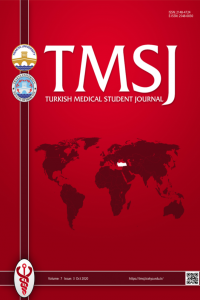Öz
Kaynakça
- 1. Carney EF. The impact of chronic kidney disease on global health. Nat Rev Nephrol 2020;16(5):251.
- 2. Rambod M, Shabani M, Shokrpour N et al. Quality of life of he- modialysis and renal transplantation patients. Health Care Manag 2011;30(1):23-8.
- 3. Jung HY, Jeon Y, Park Y et al. Better quality of life of peritoneal dialysis compared to hemodialysis over a two-year period afterdialysis initiation. Sci Rep 2019;9(1):10266.
- 4. Ng JK, Li PK. Chronic kidney disease epidemic: How do we deal with it? Nephrology 2018;23(4):116-20.
- 5. Li H, Xie L, Yang J et al. Symptom burden amongst patients suffering from end-stage renal disease and receiving dialysis: A literature review. Int J Nurs Sci 2018;5(4):427-31.
- 6. Ricardo AC, Yang W, Sha D et al. Sex-related disparities in CKD progression. J Am Soc Nephrol 2019;30(1):137-46.
- 7. de Sequera P, Corchete E, Bohorquez L et al. Residual renal function in hemodialysis and inflammation. Ther Apher Dial 2017;21(6):592-8.
Öz
Aims: This study investigates the relationship between the clinical parameters at the beginning of hemodialysis therapy and the changing in the frequency of weekly hemodialysis sessions in ongoing treatment. Methods: The study population was composed of all of the patients that were started chronic hemodialysis treatment between January 2015 and January 2020. The patients were classified as twice-weekly (2/7) and thrice-weekly (3/7) groups according to the hemodialysis schedule at the start of treat- ment. The 3/7 group is additionally subdivided according to the dialysis schedule switches to the thrice-weekly program. Basal demographics and biochemical parameters were obtained from medical records at the start of hemodialysis. Results: The total number of subjects in the study was 433 (141 in the twice-weekly program, 292 in the thrice-weekly program). Forty-six (32.6%) patients in twice-weekly hemodialysis program were shifted to a thrice-weekly program during the follow-up. The female/ male ratio in the 2/7 program is different from the 3/7 program. Serum creatinine and C-reactive protein levels were higher in patients on the 3/7 program. Serum calcium and albumin levels were higher in patients on a 2/7 program. The statistically sig- nificant increments were found in calcium, hemoglobin, hematocrit, urea, creatinine, and potassium levels between the before and after switch results of the 3/7 group which switched from 2/7. Conclusion: Urea, creatinine, and potassium levels can guide the decision to compose a hemodialysis schedule. However, patients' future weekly treatment schedules cannot be predicted by biochemical parameters obtained at the start of hemodialysis.
Anahtar Kelimeler
Hemodialysis dialysis frequency chronic kidney disease biochemical parameters
Kaynakça
- 1. Carney EF. The impact of chronic kidney disease on global health. Nat Rev Nephrol 2020;16(5):251.
- 2. Rambod M, Shabani M, Shokrpour N et al. Quality of life of he- modialysis and renal transplantation patients. Health Care Manag 2011;30(1):23-8.
- 3. Jung HY, Jeon Y, Park Y et al. Better quality of life of peritoneal dialysis compared to hemodialysis over a two-year period afterdialysis initiation. Sci Rep 2019;9(1):10266.
- 4. Ng JK, Li PK. Chronic kidney disease epidemic: How do we deal with it? Nephrology 2018;23(4):116-20.
- 5. Li H, Xie L, Yang J et al. Symptom burden amongst patients suffering from end-stage renal disease and receiving dialysis: A literature review. Int J Nurs Sci 2018;5(4):427-31.
- 6. Ricardo AC, Yang W, Sha D et al. Sex-related disparities in CKD progression. J Am Soc Nephrol 2019;30(1):137-46.
- 7. de Sequera P, Corchete E, Bohorquez L et al. Residual renal function in hemodialysis and inflammation. Ther Apher Dial 2017;21(6):592-8.
Ayrıntılar
| Birincil Dil | İngilizce |
|---|---|
| Konular | Klinik Tıp Bilimleri |
| Bölüm | Araştırma Makalesi |
| Yazarlar | |
| Yayımlanma Tarihi | 31 Ekim 2020 |
| Gönderilme Tarihi | 30 Mayıs 2020 |
| Yayımlandığı Sayı | Yıl 2020 Cilt: 7 Sayı: 3 |


